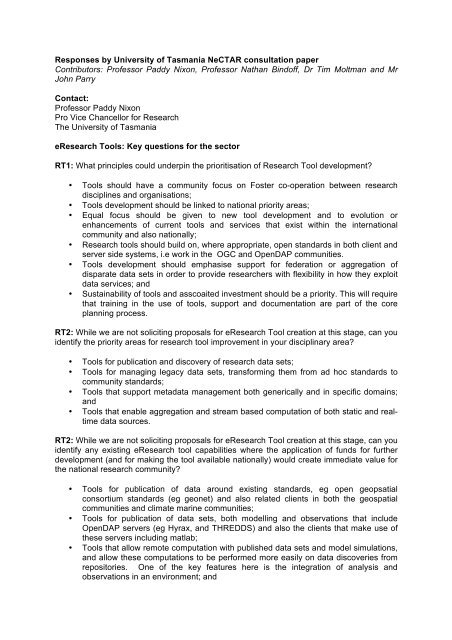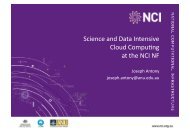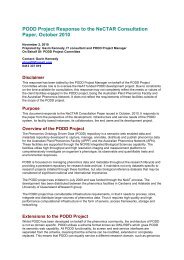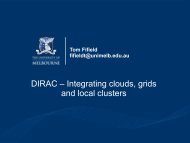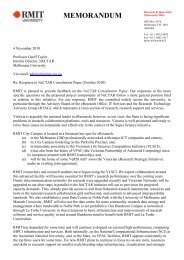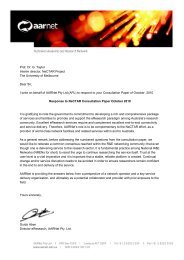UTAS - NeCTAR
UTAS - NeCTAR
UTAS - NeCTAR
Create successful ePaper yourself
Turn your PDF publications into a flip-book with our unique Google optimized e-Paper software.
Responses by University of Tasmania <strong>NeCTAR</strong> consultation paper<br />
Contributors: Professor Paddy Nixon, Professor Nathan Bindoff, Dr Tim Moltman and Mr<br />
John Parry<br />
Contact:<br />
Professor Paddy Nixon<br />
Pro Vice Chancellor for Research<br />
The University of Tasmania<br />
eResearch Tools: Key questions for the sector<br />
RT1: What principles could underpin the prioritisation of Research Tool development?<br />
• Tools should have a community focus on Foster co-operation between research<br />
disciplines and organisations;<br />
• Tools development should be linked to national priority areas;<br />
• Equal focus should be given to new tool development and to evolution or<br />
enhancements of current tools and services that exist within the international<br />
community and also nationally;<br />
• Research tools should build on, where appropriate, open standards in both client and<br />
server side systems, i.e work in the OGC and OpenDAP communities.<br />
• Tools development should emphasise support for federation or aggregation of<br />
disparate data sets in order to provide researchers with flexibility in how they exploit<br />
data services; and<br />
• Sustainability of tools and asscoaited investment should be a priority. This will require<br />
that training in the use of tools, support and documentation are part of the core<br />
planning process.<br />
RT2: While we are not soliciting proposals for eResearch Tool creation at this stage, can you<br />
identify the priority areas for research tool improvement in your disciplinary area?<br />
• Tools for publication and discovery of research data sets;<br />
• Tools for managing legacy data sets, transforming them from ad hoc standards to<br />
community standards;<br />
• Tools that support metadata management both generically and in specific domains;<br />
and<br />
• Tools that enable aggregation and stream based computation of both static and realtime<br />
data sources.<br />
RT2: While we are not soliciting proposals for eResearch Tool creation at this stage, can you<br />
identify any existing eResearch tool capabilities where the application of funds for further<br />
development (and for making the tool available nationally) would create immediate value for<br />
the national research community?<br />
• Tools for publication of data around existing standards, eg open geopsatial<br />
consortium standards (eg geonet) and also related clients in both the geospatial<br />
communities and climate marine communities;<br />
• Tools for publication of data sets, both modelling and observations that include<br />
OpenDAP servers (eg Hyrax, and THREDDS) and also the clients that make use of<br />
these servers including matlab;<br />
• Tools that allow remote computation with published data sets and model simulations,<br />
and allow these computations to be performed more easily on data discoveries from<br />
repositories. One of the key features here is the integration of analysis and<br />
observations in an environment; and
• The easy and natural deployment of simulation environments for scientific hypothesis<br />
testing is a new area for tool development. For example, a low resolution climate<br />
models like the CSIRO Mk3L, or the ecosystems models (reef scenarios) or<br />
oceanographic models like ROMS.<br />
RT3: Are you aware of any existing tools or services that would be ready, at an early stage,<br />
to engage with <strong>NeCTAR</strong> as an ‘exemplar’ project and demonstrate value to the sector?<br />
• There are many tools (eg data fabric delivered by ARCS, the computational grid<br />
operated by ARCS and increasingly used by the wider community, the AAF is<br />
particularly important and increasingly valuable as the number of services grow that<br />
are of use by the research community. Of particular note are the digital repositories<br />
operated by IMOS (or eMii) and TPAC which provide internationally utilised portals.<br />
RT4: What computing platform and interoperation standards in your field need to be taken<br />
into consideration in planning for this investment?<br />
• A number of specific standards around sensor based systems, such as the general<br />
SensorML and its associated specific instances are particularly relevant for<br />
environmental monitoring systems.<br />
RT5: What data security issues are there, specific to your field of research, that may<br />
need to be considered in planning for this investment?<br />
• Standards for security should be established by a national body and all projects<br />
directed to conform to these requirements. This will ensure a standards based open<br />
access policy is established, maintained, and developed separate from institutional<br />
governance arrangements; and<br />
• Certain communities value sharing and collaboration over explicit security<br />
mechanisms. For example, in the field of climate and oceanographic research there<br />
is a low level of data security identified by the user base.<br />
RT6: What support do you see as necessary to promote the success of <strong>NeCTAR</strong> and the<br />
provision of sustainable eResearch tool capabilities in your field of research?<br />
• Marketing: there must be clear methods of communicating the activities and<br />
informing the relevant groups about the activities in <strong>NeCTAR</strong>. It could be weekly<br />
emails, e-Research conferences, road shows, and web sites, and general literature.\;<br />
• Training is essential in getting the research community to adopt and use the tools<br />
more widely, and with greater skill. The value of training cannot be under-estimated,<br />
both of the developers, and also of the users. Many services are poorly utilised<br />
because they are not understood by the research community, and thereby loosing<br />
the opportunity to engage and transform.<br />
• Good governance is also important to inform and communicate. Commitment of the<br />
participants must be real, and the participants must have a history of tangible<br />
involvement in the e-Research activities and use of tools and their development.<br />
• The development of tools must be directed, in part, by the research users of the<br />
tools. A strong relationship to researchers and their involvement in the tool<br />
development increases the chances of successful implementations of enhanced tools<br />
and their developments.
Virtual Laboratories: Key questions for the sector<br />
VL1: While we are not soliciting proposals for Virtual Laboratory development at<br />
this stage, what research areas should be prioritised for involvement in the Virtual<br />
Laboratory component of the project?<br />
• Keys areas for the University of Tasmania are: Climate research, Marine and<br />
Antarctic Sciences, Environmental sensing and monitoring, Health data research –<br />
Rural Health, Epigenetics and Neuroscience in particular, Chemistry, Astronomy,<br />
Food Science, and perhaps less obviously the Creative Arts – with a particular focus<br />
on community engagement.<br />
VL2: Are there existing Virtual Laboratory or similar capabilities that would be ready to<br />
engage early with <strong>NeCTAR</strong> as an exemplar and demonstrate value to the sector?<br />
• IMOS is a compelling example of a highly evolved virtual collaborative laboratory;<br />
and<br />
• Early developments in the area of Human Interface Technologies are being built<br />
through a multisite virtual laboratory in collaboration with The University of<br />
Washington (USA) and Canterbury University (NZ).<br />
VL3: What additional support might be required to bring these exemplars to fruition? It<br />
should be noted that this might take the shape of existing institutional or other resources that<br />
might assist with implementation.<br />
no comment<br />
VL4: Early expressions of interest are sought to gain a sense of the size of the budget<br />
allocation and co---‐investment required.<br />
• The University of Tasmania, in conjunction with the State government and other<br />
providers, is developing exemplar projects for the near-term NBN roll-out. We<br />
propose that this specific question is made as a component of the Townhall<br />
meetings.
Research Cloud: Questions for the sector<br />
RC1: Does your research area have a preferred model for delivery of this component?<br />
• No, except that in the analysis space, the cloud computing environment should have<br />
the capacity to allow a high level of transparency to move large data sets, to analyse<br />
these data with common software tools (eg matlab, ferret, grads, octave, python, R)<br />
on remote servers with little additional overhead in terms of learning by the user.<br />
Note comments about the ARCS grid below.<br />
RC2: While we are not soliciting proposals for Research Cloud development at this stage,<br />
what existing applications should be prioritised for migration to a research cloud<br />
infrastructure? ---‐ What resources might be required to carry out this migration? ---‐ What<br />
external requirements, if any, must be met for such a migration? ---‐ What is the expected<br />
scale of demand for these resources in your research field? ---‐ What special security issues,<br />
if any, might apply to such a migration in your research field?<br />
• Range of deployable climate and ocean models, ranging from the physical to<br />
ecosystems that could be appropriately deployed in the cloud as part of a general<br />
project. The reefscenarios project is an example of this type of deployable model.<br />
• Analysis tools for marine and oceanograographic and climate data sets are perfect<br />
for cloud computing, common applications tools range from matlab, idl, ferrett, octave<br />
python.<br />
RC3: Are there any other types of infrastructure (non---‐cloud) that would better meet your<br />
needs?<br />
no comment<br />
National Servers: Questions for the sector<br />
NS1: What special server requirements does your research require, including the need for<br />
24x7 support, uptime requirements, network connectivity and redundancy?<br />
• see comments below about ARCS services. The key is in an operational system is<br />
to have a suite of sustained services that are professionally supported with<br />
reasonably intuitive interfaces. The services must be reliable and robust and operate<br />
in a "transparent" way.<br />
NS2: What existing special servers do you currently maintain?<br />
• we operate portals for discovery and access to marine and climate data on behalf of<br />
researchers national at TPAC and IMOS. We also operate OpenDAP servers,<br />
THREDDS servers, subversion repositories, licensing arrangements for numerical<br />
models eg UK Met office Unified Model, and CSIRO Mk3L.<br />
NS3: What are their server infrastructure requirements?<br />
• requirements are growing to now include servers with multiple cpu's, fast disk and<br />
high connectivity to data stores. Minimum of 16 cpu, 64 gbytes of ram and links to<br />
petabyte stores are a reasonable norm.
NS4: What sort of criteria should be devised for admitting services for virtual server support<br />
and resource allocation?<br />
• Should be sufficient demand community;<br />
• Alignment with national priority research; and<br />
• Long term sustainability.
ARCS tools and services: Questions for the sector<br />
ARCS1: What functionality delivered through the ARCS tools and services is important for<br />
your research?<br />
For our research the following are important to be sustained and operated into the future<br />
with appropriate support (both helpdesk for users and developers who depend on these<br />
services). It is important that these services are not disrupted through the transition from<br />
ARCS to <strong>NeCTAR</strong> arrangements. The following ARSC services are:<br />
• The ARCS data fabric;<br />
• The ARCS cloud or grid computing;<br />
• The AAF, essential service that improves the integration of services provided by<br />
ARCS and related service providers;<br />
• ARCS video conferencing service, which is currently EVO;<br />
• ARCS help desk and customer services that are operated nationally on a 24/7 basis;<br />
and<br />
• Professional customer and researcher support, delivered as a set of coherent<br />
working services at a national level that facilitates the research base in cross<br />
institution. Working and robust (reliable) services are central to e-Research<br />
activities, and high levels of robustness cannot be achieved with out consistent<br />
professionally applied methods of business practises that are well supported at an<br />
operational and design level.<br />
ARCS2: What changes or improvements to these services would you like to see in order to<br />
better deliver this functionality?<br />
Potential improvements and enhancements to the services ARCS has developed and<br />
delivered could include:<br />
• Systematic integration between Institutional Service Desks/Support teams (providing<br />
Tier 1 support) and a national eResearch Service Desk (providing Tier 2 and Tier 3<br />
support) for core national eResearch services;<br />
• Improvements to the look and feel of the web interface for the Compute Cloud/Grid;<br />
• Full integration between the Compute Cloud/Grid and the ARCS Data Fabric;<br />
• Standardised interface (API) for the easy building of customised applications and<br />
portals by research communities; and<br />
• Support and integration of basic workflows and discipline-specific workflows.<br />
For the ARCS Data Fabric<br />
• Development of additional research community driven interfaces and services using<br />
the underlying Data Fabric/National File System;<br />
• A simple-to-use and automatic drag-and-drop utility to remotely move very large data<br />
sets from one place to another with high performance, e.g., either across the country,<br />
between storage sites or into and out of the Data Fabric;<br />
• Development of improved desktop and hand-held device integration including<br />
automatic synchronisation;<br />
• An increased capability to store confidential data to meet sector needs including,<br />
e.g., medical and population health data, bio-secuity data, criminal justice data, etc;<br />
• Performance improvements through closer integration with underlying storage<br />
infrastructure and, in particular, with the forthcoming RDSI nodes.<br />
ARCS Compute Cloud and Grid
• Improvements to the look and feel of the web interface for the Compute Cloud/Grid;<br />
• Full integration between the Compute Cloud/Grid and the ARCS Data Fabric;<br />
• Standardised interface (API) for the easy building of customised applications and<br />
portals by research communities; and<br />
• Support and integration of basic workflows and discipline-specific workflows.<br />
ARCS Video Conferencing<br />
• Creation of additional connectivity Bridges to enable researchers to attend EVO<br />
meetings using other services, e.g., in addition to the existing Telephone Bridge and<br />
AccessGrid Bridge, add bridges to the AARNet Video Conference service, Skype and<br />
other common video-conferencing services;<br />
• Improvements in audio quality for EVO, AccessGrid and the Telephone Bridge;<br />
• Improved and simplified user interface to provide a more seamless and enjoyable<br />
user experience;<br />
• Enhancements to meetings including "broadcast" and "plenary/teaching" modes<br />
which enable easy-to-use recording of meeting/sessions to a web based portal (using<br />
the “Data Fabric” for file storage and sharing) to enable replay and sharing of the<br />
meeting/presentation/session/lecture. (e.g., an automatic Webinar service);<br />
• Integrating AAF authentication into EVO so that users can use their institutional<br />
usernames and passwords for easy access; and<br />
• Improved Whiteboard functionality to improve the ability for users in a meeting to<br />
jointly annotate a document, photograph or image which they are simultaneously<br />
viewing.<br />
ARCS Security Services<br />
• Develop and deliver tools which allow Service Providers to deliver access to any of<br />
their non-Web-based services via the AAF, (the AAF is only designed to operate with<br />
Web-based services);<br />
• Work with the AAF, the research sector and IdPs to develop a comprehensive list of<br />
AAF attributes that are optimised to allow a significant fraction of authorisation<br />
decisions for eResearch services to be automated.


